There was big news last week, as the Chicago Department of Transportation shared plans for what's basically our city's first Neighborhood Greenway side street bike-ped route with traffic diverters. That's infrastructure to prevent drivers from using residential roads for "cut-through" crosstown trips, creating a safer, lower-stress corridor for people walking and biking.
The project includes installing diverters at major intersections along a little over a mile of Wood Street (1800 W.) between Grand (500 N.) and Milwaukee Avenue (1430 N.) The route is located in the 1st and 36th wards, which are represented by bike-friendly alderpersons Daniel La Spata and Gilbert Villegas, respectively.
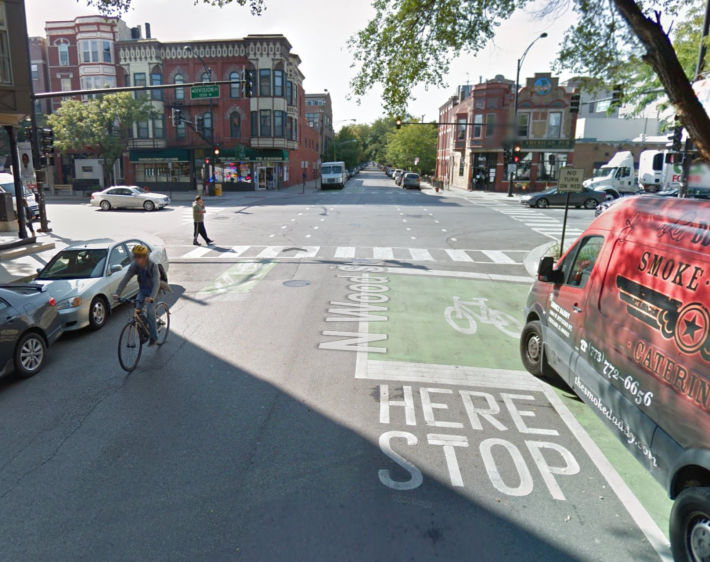
Wood was one of the first Neighborhood Greenways in Chicago and is a popular north-south route for bike riders. Currently it features "sharrow" bike-and-chevron pavement markings and painted "bike boxes" to allow cyclists to wait in front of drivers at red lights. There's also a contraflow "wrong-way" southeast-bound bike lane on a northwest-bound-only block of the greenway route on Wicker Park Avenue near Milwaukee/Wood.

However, Wood Street is also commonly used as cut-through route for drivers avoiding motorist-generated traffic jams on nearby arterial roads Damen (2000 W.) and Ashland (1600 W.) avenues. The planned traffic diverters will force drivers traveling on Wood to make turns onto Chicago Avenue (800 N.), Augusta Boulevard (1000 N.) or Division Street (1200 N.), exiting the residential road. Gaps in the infrastructure will allow people on bikes to continue straight along the greenway route.

Wood is a narrow, two-way residential street with parking on both sides. Bike riders must share the travel lane with drivers. It is common for two motorists traveling in opposite directions to scarcely have room to pass one another, creating a high-stress situation for cyclists on the route. Drivers using Wood as a cut-through exacerbate the problem, causing congestion on what was intended to be a quiet neighborhood street, and endangering vulnerable road users.
The changes presented at the July 25 community meeting are actually a major revision to an existing plan for a safer Wood Street. In the 2021 1st Ward participatory budgeting election, a majority of voters approved building protected bike lanes on the greenway route, earmarking $325,000 of the ward’s "menu" infrastructure money.
CDOT drafted a plan to convert the greenway into a one-way northbound street to create space for the protected lanes. After some Not In My Back Yard-style opposition to the proposal, the plan to make Wood one-way for drivers was changed. But the new proposal is probably further upsetting many of the NIMBYs who don't want to have to change their driving habits.
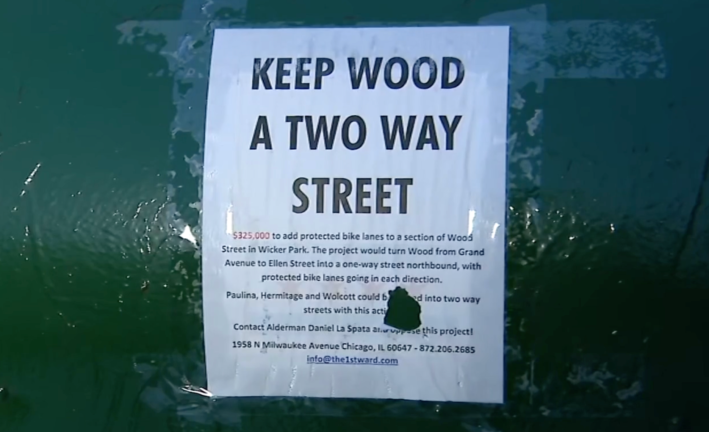
At Division, curbs installed in the middle of the road at Wood would prevent northbound and southbound drivers from continuing on the side street, instead requiring them to make a right turn onto the arterial street. Motorists traveling east or west on Division would be able to continue straight or turn right onto Wood, but not left. But, again, bike riders on Wood would be permitted to continue north or south.
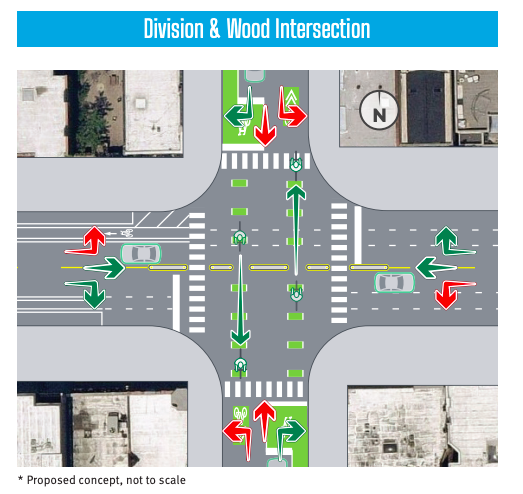
At Augusta, drivers traveling south on Wood will be able to travel straight and turn right or left. Northbound motorists would be required to turn right or left, but not continue straight, due to a new traffic island on the northeast side of the intersection. Eastbound and westbound drivers on Augusta will be allowed to continue straight or turn south onto Wood, but the island will prevent them from heading north there.
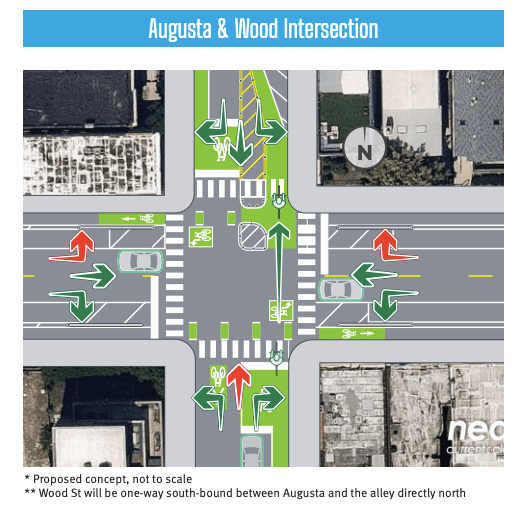
At Chicago Avenue, as with Division, new curbs will require northbound and southbound drivers on Wood to turn right onto the arterial. Eastbound and westbound motorists on Chicago may continue straight or turn right onto Wood, but not left.
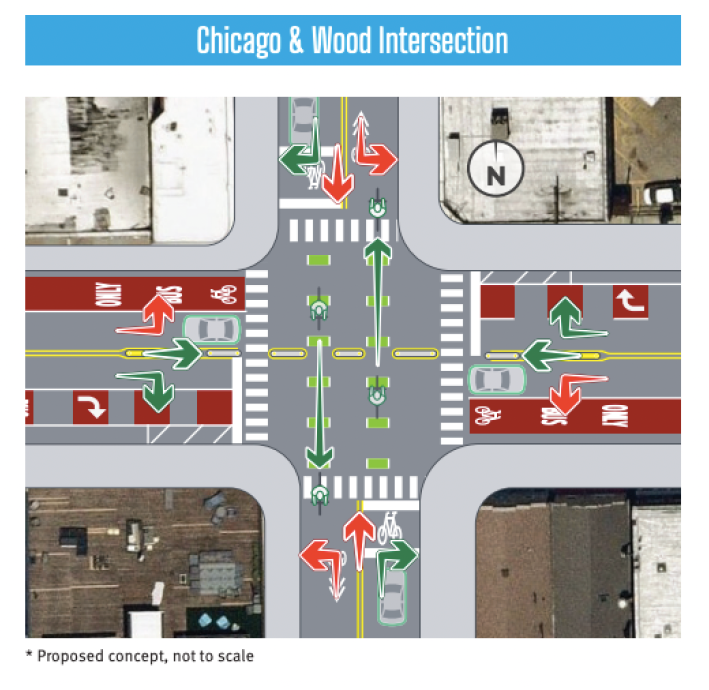
CDOT has not yet finalized the design of the traffic diverters. Materials presented at the community meeting show examples of possible options. In the handouts, CDOT states that "Some designs also allow emergency vehicles to cross the diverter, to reduce impacts to emergency operations." The department expects to install the diverters with temporary materials as a pilot project by spring 2024, and then collect data about the design and build permanent infrastructure by 2025.
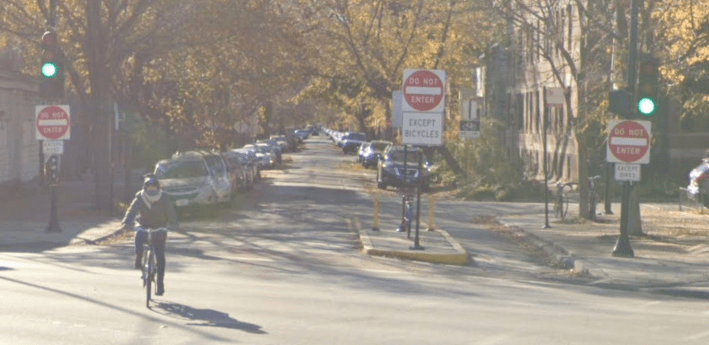
As Streetsblog wrote in 2020, traffic diverters are a common sight in West Coast cities like Portland, Seattle and Long Beach, and an effective traffic calming measure. While the new plan is a major change from the Wood protected bike lane plan that was approved during the 2021 PB election, installing traffic diverters will go a long way towards making the Neighborhood Greenway truly bike-friendly.

Did you appreciate this post? Please consider making a tax-deductible donation.





